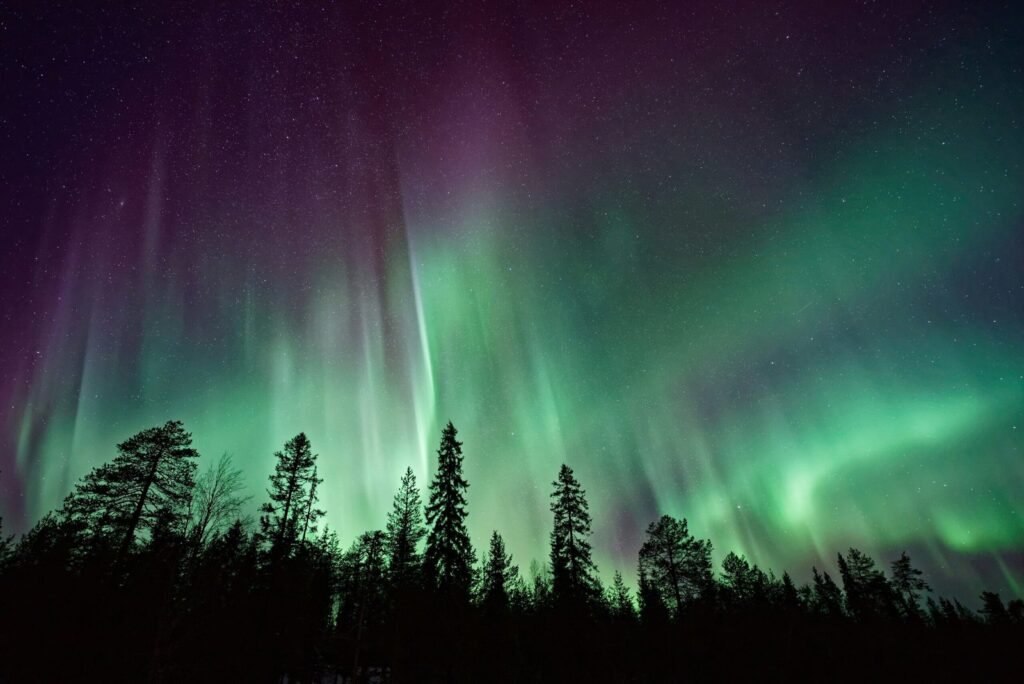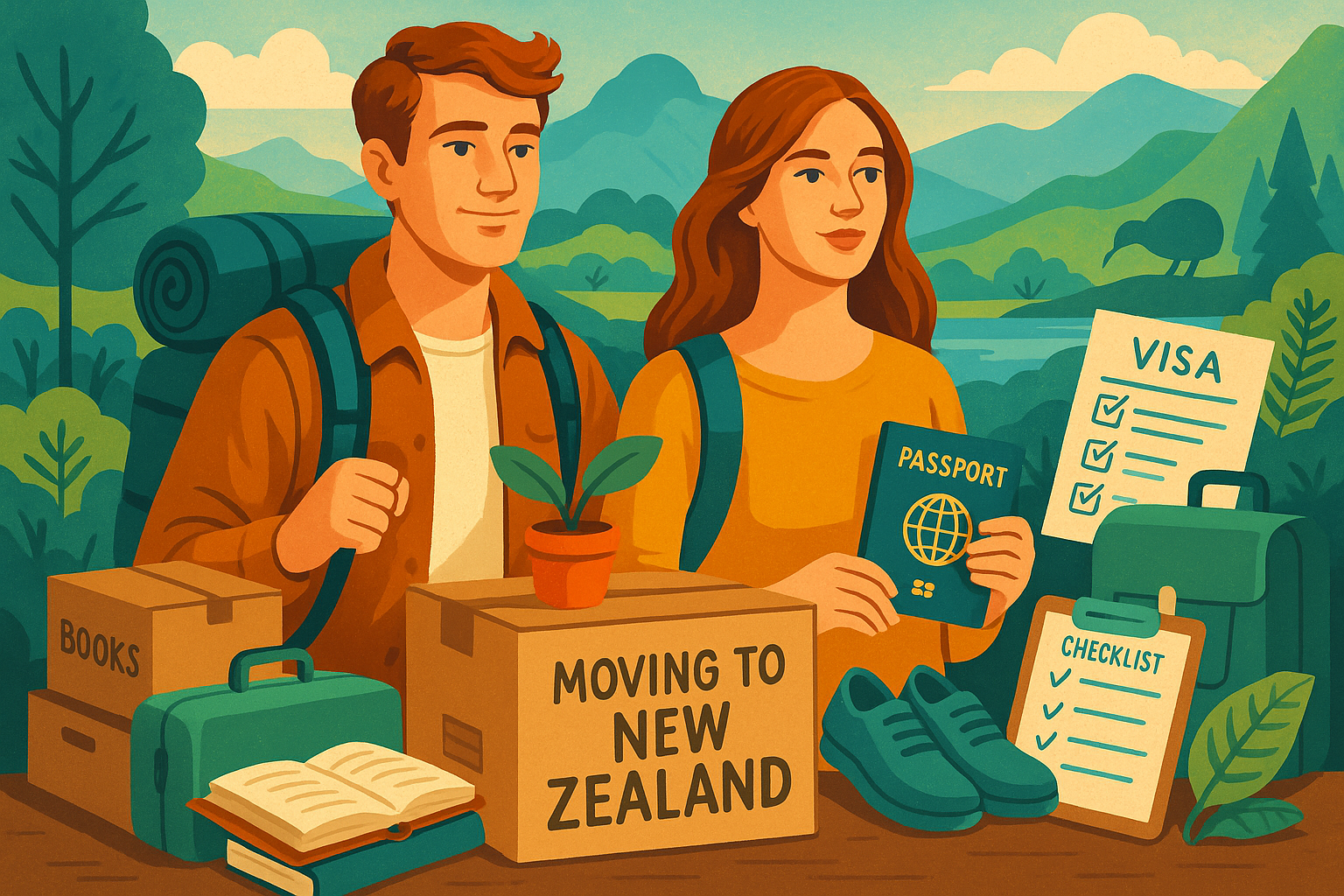Table of Contents
Introduction to the Northern Lights
The Northern Lights, or Aurora Borealis, represent one of nature’s most extraordinary spectacles, captivating observers with their shimmering displays of color. This phenomenon occurs when charged particles emitted by the sun collide with gases in the Earth’s atmosphere. Primarily during periods of heightened solar activity, these particles interact with the Earth’s magnetosphere and result in vibrant waves of light that dance across the night sky, often showcasing hues of green, pink, red, and violet.
The science behind the Northern Lights is rooted in solar meteorology. As solar storms occur, they release a stream of solar wind, which is composed of high-energy electrons and protons. When these particles reach Earth, they can become trapped in the polar magnetic fields, causing electrons in atmospheric gases, such as nitrogen and oxygen, to become energized. This energy release is what manifests as visible light, creating the ethereal beauty associated with the Aurora Borealis.

Beyond their scientific explanation, the Northern Lights hold profound cultural significance, particularly within Indigenous communities across Canada and the Arctic regions. Many Indigenous peoples view the lights as a spiritual connection, interpreting them through various myths and legends that convey meanings of guidance, protection, or messages from ancestors. For these communities, the Northern Lights symbolize resilience and a deep relationship with the natural world.
For travelers, the allure of witnessing the Northern Lights serves as a major draw, promoting activities such as aurora chasing in destinations like Yukon, Northwest Territories, and Nunavut. Each year, thousands of visitors seek the ideal vantage points to experience this breathtaking display, adding to the rich tapestry of human connection to one of Earth’s most remarkable phenomena.
Best Time to See the Northern Lights
The Northern Lights, or Aurora Borealis, are a breathtaking natural phenomenon that can be enjoyed in Canada, particularly in the northern regions. The best time to witness this spectacular light display typically falls between late autumn and early spring, with peak viewing periods often occurring from December to March. These months provide longer nights and more hours of darkness, which are essential for optimal visibility of the aurora.
Weather conditions play a crucial role in experiencing the Northern Lights. Clear skies are necessary for viewing, as clouds can obstruct the aurora. To increase the chances of encountering favorable weather, it is advisable to plan trips during the winter months when temperatures are low but skies tend to be clearer. Locations with low humidity levels are also ideal, as humidity can lead to cloud formation, hindering visibility.
Moreover, the impact of light pollution should not be underestimated. It is recommended to venture away from urban areas and find locations with minimal artificial lighting. Rural settings or dedicated dark sky parks are often perfect for witnessing the Northern Lights. These spots allow for an unobstructed view of the celestial display, further enhancing the experience.
In addition to weather conditions and light pollution, solar activity significantly influences the visibility of the Northern Lights. The Sun operates on an approximate 11-year cycle of solar activity, with periods of higher activity increasing the chances of vivid auroras. Checking solar forecasts and the Kp index, which measures geomagnetic activity, can help travelers identify ideal conditions for viewing the Northern Lights during their visit to Canada.
Top Destinations in Canada for Aurora Viewing
Canada is home to some of the most stunning locations for witnessing the Northern Lights, positioning itself as a premier destination for aurora enthusiasts. One of the foremost locations is Yellowknife, situated in the Northwest Territories. Known for its clear skies, Yellowknife offers optimal conditions for aurora viewing, especially between late August and mid-April. The city is accessible via direct flights from major Canadian cities, and its proximity to natural attractions such as Great Slave Lake enhances the experience. Local tour operators provide guided trips that promise exceptional chances to witness the captivating dance of the auroras.
Another remarkable destination is Whitehorse in the Yukon Territory. This charming capital city provides excellent opportunities for aurora sighting, with the aurora season typically running from late August to mid-April. Whitehorse is easily reachable by air, and its well-developed infrastructure makes travel comfortable for visitors. The surrounding wilderness adds a unique backdrop to the spectacle, with numerous locations, such as the Takhini Hot Springs, offering a combination of relaxation and awe-inspiring views of the Northern Lights.
Additionally, the remote areas of Nunavut are notable for their unpolluted skies and picturesque landscapes that create a captivating environment for experiencing the aurora borealis. While more challenging to access, these lesser-known locations offer ideal conditions for seeing the Northern Lights from September through April. Tourists can engage with local Indigenous communities to learn about their cultural connection to the aurora, transforming a simple viewing into a rich, educational experience. Each of these destinations presents distinct features and accessibility options that cater to different preferences and levels of adventure, making Canada a world-class hub for Northern Lights enthusiasts.
Tips for Chasing the Northern Lights
Experiencing the Northern Lights, or aurora borealis, is a remarkable event that requires careful planning and preparation. First and foremost, appropriate clothing is essential. Dressing in layers not only provides warmth but also allows for adjustments in varying temperatures. Thermal undergarments, insulated jackets, waterproof outer layers, and insulated boots should be considered crucial components of your wardrobe. Additionally, wear accessories such as gloves, hats, and scarves to protect extremities from the cold.
Understanding aurora forecasts can significantly enhance your chances of seeing this spectacular light display. Several websites and applications provide real-time aurora alerts and predictions. Monitoring solar activity, especially during periods of heightened solar flares, can provide insight into aurora visibility. Look for a Kp index of 4 or higher to increase the likelihood of witnessing the lights, as this indicates a greater level of geomagnetic activity. Joining local groups or online communities can also help in gathering essential information regarding current conditions and tips for viewing.
When selecting a viewing location, opt for areas far removed from city lights to minimize light pollution. Remote locations with clear, unobstructed views of the night sky are ideal. National parks, lakes, and open fields are excellent choices that offer vast horizons for uninterrupted observation. As the Northern Lights can be unpredictable, patience is key. Weather conditions and aurora activity can fluctuate rapidly, so planning for flexible viewing nights is advisable. Carrying essential gear such as a sturdy tripod and a camera with manual settings will aid in capturing the beauty of this natural phenomenon.
Ultimately, embracing flexibility and remaining optimistic about the conditions will enhance your experience of chasing the Northern Lights. By preparing adequately and staying informed, you can greatly improve your chances of witnessing this breathtaking display of nature.
Photography Tips for Capturing the Northern Lights
Capturing the breathtaking beauty of the Northern Lights requires careful preparation and knowledge of photography techniques. To begin, selecting the right equipment is crucial. A DSLR or mirrorless camera that allows for manual settings is ideal, as it provides greater control over exposure and focus. A sturdy tripod is also essential to prevent camera shake during long exposures, which are typically necessary for photographing the aurora borealis.
When it comes to camera settings, start with a wide aperture, ideally between f/2.8 and f/4, to allow maximum light. A high ISO setting, between 800 and 3200, will help your camera capture the dim light emitted by the Northern Lights. Exposure times can vary based on the intensity of the aurora and surrounding conditions; typically, exposures range from 5 to 30 seconds. However, it’s important to experiment with different settings to achieve the best results under varying light circumstances.
Being mindful of your composition can significantly enhance your photographs. Including elements of the landscape, such as trees or mountains, can add depth and context to your aurora shots. Consider the rule of thirds for a balanced composition. Additionally, if the auroras are particularly vibrant, you may want to capture the colors with a longer exposure; this reveals the full beauty of the display.
Lastly, as the light conditions change rapidly, being adaptable is essential. Continuously evaluate your settings and adjust as necessary. Utilize a remote shutter or the camera’s self-timer to avoid any movement when taking the shot. With these photography tips and techniques, you will be well-equipped to capture stunning images of the Northern Lights that reflect their enchanting beauty.
Cultural Experiences and Tours
While the mesmerizing sight of the Northern Lights draws many visitors to Canada, the cultural experiences that accompany this natural phenomenon can significantly enhance the journey. Various tours are designed to merge the incredible spectacle of the aurora borealis with the rich cultural heritage of the regions. These experiences not only showcase the beauty of the lights but also immerse visitors in the traditions and lifestyles of local Indigenous communities and other cultural groups.
Indigenous guided tours offer unique insights into the significance of the Northern Lights in various Native cultures. These tours often include storytelling sessions where guides share their ancestral narratives and folklore related to the aurora. Understanding these stories can heighten the appreciation of the lights, transforming the viewing experience into a more profound cultural exploration. Visitors can learn about the connection between the environment and Indigenous beliefs, deepening the meaning behind this stunning natural display.
Additionally, many tour operators integrate traditional activities such as dog sledding or snowshoeing into their Northern Lights packages. These activities provide a hands-on experience of winter traditions that have been part of Canadian culture for centuries. Dog sledding, for instance, allows participants to engage with the stunning snowy landscape in a thrilling yet respectful manner, often culminating in a stop under the stars where the auroras are expected to appear. Snowshoeing, on the other hand, offers an opportunity to traverse trails that might otherwise remain hidden, revealing beautiful views of the surrounding nature while keeping an eye on the skies for the enchanting lights.
Combining these cultural experiences with the aurora viewing enriches the trip, transforming it from merely a visual spectacle into a holistic journey celebrating nature and heritage. Through these experiences, travelers can create lasting memories that extend beyond the breathtaking beauty of the Northern Lights, allowing them to connect deeply with the land and its people.
Safety Considerations for Aurora Chasers
When embarking on an adventure to witness the breathtaking Northern Lights in Canada, it is paramount to prioritize safety. The key is to dress appropriately for the cold weather, as temperatures can plummet, particularly during the night when aurora displays are most visible. Layers are your best friend, allowing you to manage body heat while remaining comfortable. Thermal undergarments, insulated outer layers, hats, gloves, and waterproof boots are essential to ensure your warmth and mobility as you wait outside for the spectacular light show.
Understanding the infrastructure of remote areas is another crucial aspect of safety when hunting for the auroras. Many prime viewing spots are located far from urban amenities, which means access to basic necessities like food, water, and restroom facilities may be limited. Prior planning is necessary; be sure to inform someone of your destination and estimated return time, as well as ensure you have a reliable means of communication, such as a fully charged mobile phone. It may also be prudent to have a portable charger on hand.
Wildlife encounters can occur, especially in rural or national park settings. It’s advisable to remain vigilant and aware of your surroundings, particularly at dawn or dusk when animals may become more active. Familiarize yourself with the local wildlife and understand what precautions to take, such as making noise to announce your presence or keeping a safe distance if spotting wild animals.
Lastly, travel safety in extreme conditions cannot be overstated. Ideal weather conditions are vital for a successful aurora chase, so be attentive to forecast updates. Consider having an emergency kit in your vehicle, including blankets, snacks, water, and a first aid kit. By taking these safety considerations into account, you can fully enjoy the magical experience of witnessing the Northern Lights while ensuring that your adventure remains safe and enjoyable.
Sustainability and Responsible Tourism
As travelers venture to witness the mesmerizing Northern Lights in Canada, it is essential to emphasize the importance of sustainability and responsible tourism practices. The awe-inspiring natural phenomenon not only captivates visitors but also underscores our duty to protect these fragile environments for future generations. To minimize environmental impact, travelers must adopt conscientious behaviors during their journey.
One of the most effective ways to reduce your carbon footprint is to choose eco-friendly transportation options. When planning your trip, consider utilizing public transport, carpooling, or even opting for electric vehicles. Additionally, minimizing energy consumption in your accommodations can make a significant difference. Look for eco-certified lodgings that employ sustainable practices, such as using renewable energy sources and implementing waste reduction systems.
Respect for local cultures and communities is another critical aspect of responsible tourism. Seek out opportunities to engage with Indigenous peoples and learn about their traditions, beliefs, and conservation efforts. Participating in guided tours led by local operators not only enhances your experience but also ensures that your visit contributes positively to their economy. Make it a goal to support businesses that prioritize sustainability and cultural respect, as this will help preserve the area’s rich heritage.
Travelers should also be mindful of wildlife and natural habitats during their excursions. Observing the Northern Lights should not come at the expense of the ecosystems that support these experiences. Maintain a safe distance from wildlife and follow guidelines set by park rangers. This respect for nature aids in the protection of both the environment and the unique species that inhabit it.
By embracing sustainable travel practices, visitors to Canada’s Northern Lights can ensure that their journey leaves a positive imprint on the environment and local communities. Cultivating a mindset of responsibility will not only enrich the travel experience but also contribute to the long-term preservation of these breathtaking landscapes.
Conclusion and Final Thoughts
The phenomenon of the Northern Lights, or Aurora Borealis, is a breathtaking display of natural beauty that captivates many travelers around the world. Throughout this exploration of the Northern Lights in Canada, we have highlighted the prime locations and essential tips for successfully witnessing this ethereal spectacle. Destinations such as Yellowknife, Whitehorse, and Jasper National Park have emerged as top spots due to their clear skies and optimal viewing conditions. Each location offers a unique experience, making it essential for visitors to choose according to their preferences and travel itinerary.
Embracing the adventure of chasing the Northern Lights not only allows one to witness a stunning visual masterpiece but also provides an opportunity to engage with the rich cultural tapestry of Canada. Indigenous perspectives enrich the experience, encouraging visitors to appreciate the deeper meanings attributed to the lights. Furthermore, the regional outdoor activities, such as snowshoeing and dog sledding, enhance the overall adventure and create memorable moments amidst the Northern wilderness.

As you consider planning your trip to see the Northern Lights, remember the importance of responsible travel practices. Respect the natural environment and local communities, ensuring that your visit contributes positively to these remarkable places. Shared experiences can foster a greater appreciation for this breathtaking phenomenon, so consider documenting your journey and sharing your stories with others. By doing so, you not only preserve the memory for yourself but also inspire fellow adventurers to embark on their own quest for the Aurora Borealis.
In conclusion, the Northern Lights in Canada offer a mesmerizing blend of natural wonder and cultural richness that captivates all who seek it. Prepare for your journey, embrace the experience, and savor the magic that awaits you under the shimmering skies.




